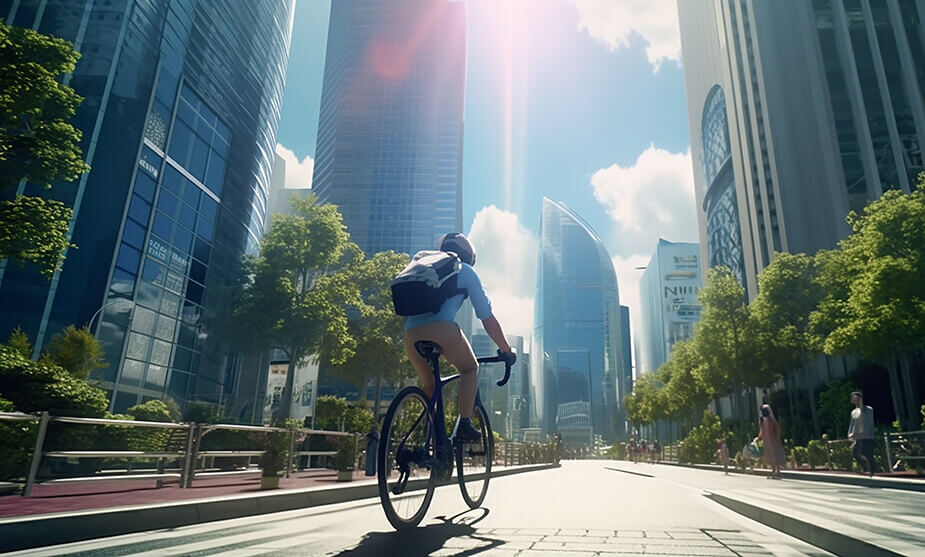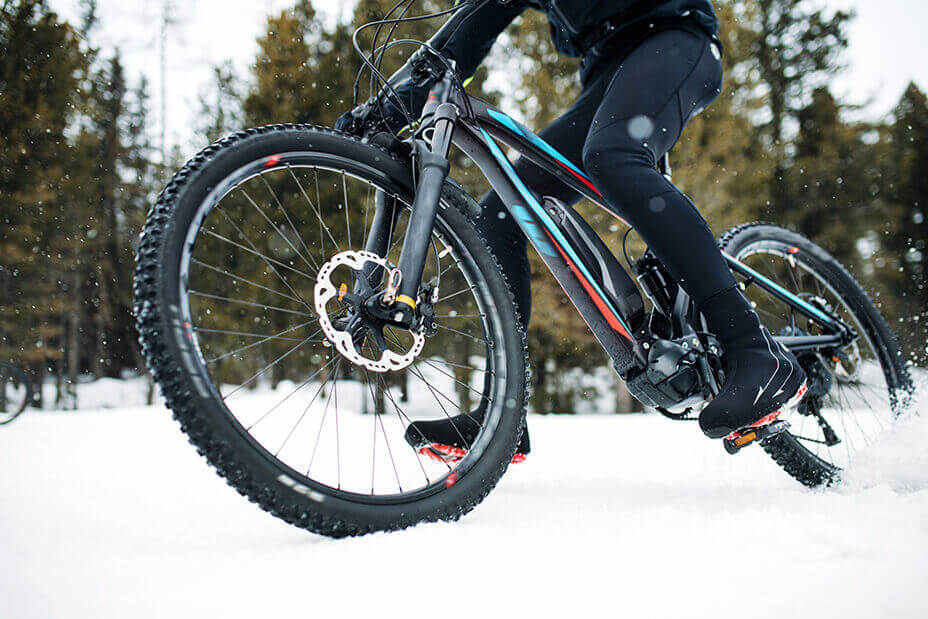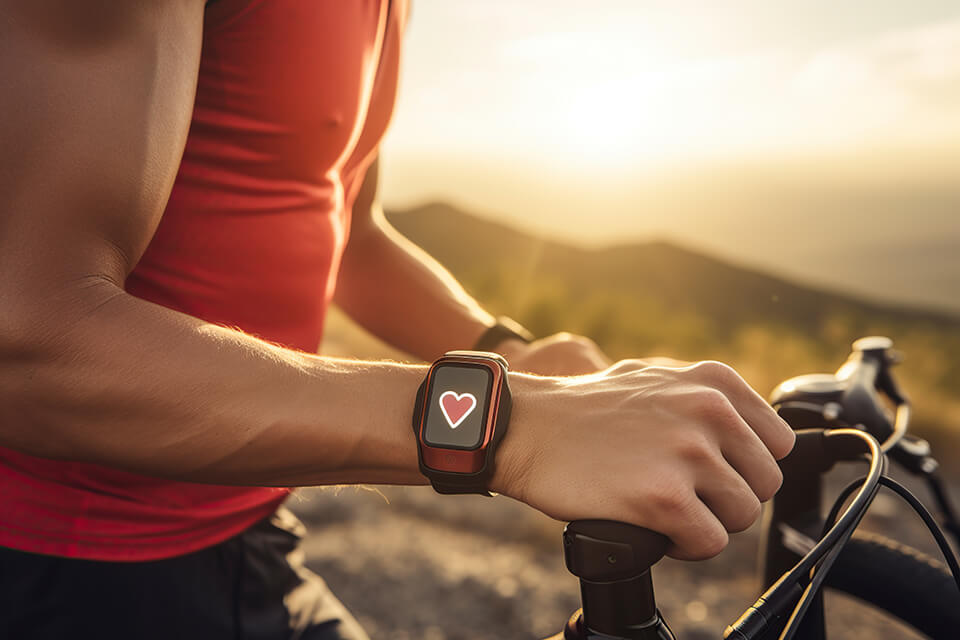Cycling is not only an excellent way to enjoy the fresh air but also an eco-friendly mode of transportation. However, staying safe while navigating the streets is a top priority for cyclists. With an alarming 97 percent of bike accident victims not wearing helmets and head injuries being the leading cause of fatal accidents, it’s time we take a fresh look at essential safety tips for a secure ride. Are you ready to level up your cycling game and ensure your safety on the road? This blog post will guide you through choosing the right gear, mastering essential bike handling skills, and planning for safe cycling in different conditions, all with a focus on safety cycling.
Key Takeaways
- Choose the right gear and get a proper helmet fit for safe cycling.
- Wear bright & reflective clothing to increase visibility up to 250 meters.
- Adapt your speed & style based on road conditions for safer rides!
Choosing the Right Gear for Safe Cycling

Selecting the right gear is pivotal for bike safety, which includes:
- Helmets: Wearing a well-fitted helmet can reduce the risk of serious injury by up to 70 percent, making it a non-negotiable item for every cyclist.
- Bike mounting and charging: Ensuring your bike is mounted and charged correctly can enhance your safety on the road.
- Clothing: Sporting bright and reflective clothing can significantly enhance your visibility and safety.
Remember, a safe and enjoyable bike ride starts with the right gear and proper bicycle safety.
Comfort and safety are also enhanced by professional bicycle fitting and adjustments, especially for long-distance or frequent riders. Having your bike professionally fitted reduces the risk of injuries and discomfort while cycling, allowing you to enjoy the many benefits of this activity without compromising your well-being.
Helmet Selection and Fit
Life and death can hinge on the selection and fitting of the right helmet. A properly fitted helmet can reduce the risk of:
- head injury by 45%
- brain injury by 33%
- facial injury by 27%
- fatal injury by 29%
With these impressive statistics, there’s no excuse for not wearing a helmet while cycling.
Visiting a cycling shop can help you find the perfect helmet, where experts can assist you in choosing the right model and size for your needs. A well-fitted helmet will not only protect you from potential head injuries but also boost your confidence on the road, allowing you to enjoy your ride with peace of mind.
Bike Mount & Charge Case, Lights, and Cleaning

For a smooth and safe cycling experience, a phone mount for your bike and charging case is a great addition to allow you to keep your phone fully charged and within view on all of your rides.
By maintaining your bike in top condition, you reduce the risk of equipment failure and accidents, such as a flat tire, especially when navigating around parked cars or crossing train tracks.
Moreover, having permanent running lights on your bicycle, including a green light, can drastically reduce the number of injuries and accidents involving cyclists, ensuring your visibility even in low-light conditions.
Regular cleaning and lubrication of your bike chain maintains your bike in optimal condition. This not only eliminates unpleasant noises but also protects costly parts, such as chainrings, from premature wear and tear. Remember, a well-maintained bike is a safe bike.
Bright and Reflective Clothing
In cyclist safety, visibility holds a significant role. Wearing bright and reflective clothing increases your visibility to drivers, reducing the risk of accidents. Reflective gear, such as vests, arm bands, and headlamps, is essential in making you more visible to other road users, especially during nighttime or low-light conditions.
Adding reflective tape to your bike can also boost your visibility by up to 250 meters, ensuring that drivers can spot you from a safe distance. Remember, the more visible you are, the safer you’ll be on the road.
Bicycle Fit and Adjustments
Ensuring comfort and safety while cycling hinges on a professional bike fit. By having your bike perfectly tailored to your body type and riding style, you can prevent injuries and enjoy a more comfortable ride, especially for long-distance or frequent cyclists.
To get the best fit possible, visit a bike shop or consult a certified bike fitter. They can adjust the saddle height, handlebar height, and stem length to ensure you have a comfortable and efficient ride.
Regular maintenance of your bike fit is also essential to guarantee that the adjustments are always optimal for your body type and riding style.
Mastering Essential Bike Handling Skills

For cyclist safety, mastering essential bike handling skills is integral. Riding in a straight line, signaling and communicating with other road users, and navigating common road hazards, including dedicated bike lanes, are all crucial skills that can significantly enhance your safety on the road. By practicing these skills and incorporating them into your daily cycling routine, you’ll become a more confident and responsible cyclist, ready to tackle any challenge that comes your way.
Keep in mind, adhering to traffic laws and following the rules of the road contribute to road safety while sharing the road with other vehicles, pedestrians, and cyclists. Remember, the same rules apply to everyone on the road. Being mindful of your surroundings and anticipating potential risks will help you adopt defensive riding strategies like scanning the road ahead, signaling your intentions with hand signals, and monitoring your speed to maintain a smooth traffic flow.
Riding in a Straight Line
Reducing the risk of accidents requires maintaining control and predictability while riding. Riding in a straight line not only helps you stay in control but also makes it easier for other road users to anticipate your movements when going in the same direction. To maintain control and ride in a straight line, keep your hands on the handlebars, your feet on the pedals, and your eyes focused on the road ahead.
Staying alert and prepared for any changes in the road, such as potholes or debris, is also vital for a safe cycling experience. Be mindful of any traffic or other cyclists in the area and adjust your speed and riding style accordingly to stay one step ahead of potential hazards.
Signaling and Communicating with Other Road Users
Cyclist safety hinges on clear communication with other road users. By using the following signals, including traffic signals, you can effectively communicate your intentions to drivers and other cyclists, helping to avoid potential conflicts and accidents:
- Turn signals
- Brake lights
- Hand gestures
- Horn in emergencies
Knowing bike hand signals is beneficial for communicating with nearby drivers and cyclists, giving advance notice of your movements. Practice these hand signals and incorporate them into your daily rides to enhance your safety and the safety of those around you.
Navigating Common Road Hazards
Avoiding accidents and maintaining control of your bicycle while navigating common road hazards like potholes and debris, demands practice and skill. By being mindful of your environment and anticipating potential hazards, you can adopt defensive riding strategies like scanning the road ahead, signaling your intentions with hand signals, and monitoring your speed.
In addition to being aware of your surroundings, it’s essential to adjust your riding style according to the road conditions. For example, slowing down when approaching wet or slippery surfaces can help maintain control and prevent accidents. Remember, adaptability is key to staying safe in various road conditions.
Planning for Safe Cycling in Different Conditions

Checking the weather forecast, planning your route, and adapting to diverse road conditions are involved in planning for safe cycling in different conditions. By staying informed about potential weather changes and choosing the safest routes, you can avoid dangerous weather conditions and ensure a secure cycling experience.
Remember, safe cycling requires proactive planning and adaptation to various conditions. Always be prepared for any changes in the weather, road conditions, or traffic, and adjust your riding plans accordingly to maximize your safety and enjoyment on the road.
Weather Forecast and Route Planning
Avoiding dangerous weather conditions and choosing the safest routes can be aided by:
- Checking the weather forecast
- Planning your route in advance
- Using a reliable weather app or website for accurate forecasts
- Researching routes with the least amount of traffic
- Researching routes with the most bike-friendly infrastructure.
Cycling route planning apps and firsthand tips from experienced cyclists can also help you identify the safest and most enjoyable routes. Join a local cycling group or ask for advice from friends or family who are experienced cyclists to get valuable insights on the best routes for your rides.
Adapting to Road Conditions
Maintaining control and preventing accidents while cycling on different road conditions like wet or slippery surfaces calls for caution and awareness. By adjusting your speed and riding style to the conditions of the road, you can avoid a situation where you might lose control and prevent any accidents.
Be mindful of the road surface and any potential hazards, and exercise caution when navigating them. Additionally, be aware of the traffic around you and be prepared to take evasive action if necessary. Remember, staying safe on the road means being adaptable and proactive in response to various road conditions.
Summary
In conclusion, ensuring your safety while cycling involves choosing the right gear, mastering essential bike handling skills, and planning for safe cycling in different conditions. By wearing a properly fitted helmet, maintaining your bike, and wearing bright and reflective clothing, you can significantly enhance your safety on the road. Additionally, practicing essential bike handling skills, such as riding in a straight line, signaling and communicating with other road users, and navigating common road hazards, can greatly improve cyclist safety.
Remember, staying safe on the road is not just about following traffic laws but also being proactive and adaptable to various conditions. Keep these essential safety tips in mind and enjoy a secure and exhilarating cycling experience.
Frequently Asked Questions
How can I be safe while cycling?
To be safe while cycling, always wear a helmet, follow the rules of the road, and use lights and reflective materials to make yourself visible. Make sure to check your equipment beforehand, keep your hands on the handlebars, and ride with the flow of traffic.
What is the most important safety rule in cycling?
Wearing a helmet is the most important safety rule in cycling. It is essential to protect your head and should be done with every ride, as many areas require helmets for children. The science is clear: wearing a helmet is the safest way to go!
Why is it called safety bicycle?
The 'Safety Bicycle' was given this name because it was safer to ride than the traditional High Ordinary or Penny Farthing cycles, and was noted and marketed as such in the 1880s. This design is still used today, although the term itself has become obsolete.
What is safety bicycle speed?
You should bike to work at a safety bicycle speed of 8 mph (for women) or 9 mph (for men). That's about the same top speed as a house mouse and a pig, respectively.
How can I improve my visibility while cycling?
Boost your visibility while cycling by wearing bright and reflective clothing, using reflective gear, and adding reflective tape to your bike. These simple steps will make you more visible on the roads.




Leave a comment
This site is protected by hCaptcha and the hCaptcha Privacy Policy and Terms of Service apply.